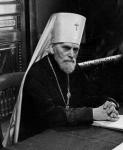Articles
/
Eparhy of Novgorod
Eparhy of Novgorod
Subject /
Religion. Church/Confession life
Subject /
Ethnic culture/Ethnic communities/
Subject /
Ethnic culture/Ethnic communities/
Subject /
Ethnic culture//
Eparhy of Novgorod. It is one of the oldest eparchies in Russia (it has been being since 992). The eparchy was the largest, it included five administrative regions (pyatinas) as well as the Pskov, Onega Lake, Karelia lands and the region of the Dvina River. Pyatinas included more ancient political units - pogosts, which had appeared under St. Princess Olga. Pogosts' borders appropriated to church parishes. The Eparchy of Novgorod included the territory of the present-day St. Petersburg eparchy. Originally bishops were appointed by the Metripolitan of Kiev; during 1158-1478 in contrast to another eparchies the Bishop of Novgorod and parish clergy were elected by Veche (the Assembly) of Novgorod. St. John was the first (from the 1120s) who reseived the title of the Archbishop of Novgorod and Pskov. Archbishops of Novgorod ( titled as Metropolitans of Veliky Novgorod and Velikiye Luki during 1589-1721) put into practice administrative and state-political functions. The Cathedral of St. Sophia in Novgorod (built in 992) was the first built church (on present days it is the oldest Russian church in the Russian Federation). By the middle of the 12th century in Ladoga there were more than seven stone churches. In the 14th-15th centuries the Archbishop House of Novgorod became the heaviest landlord, Grounds of archbishops and Novgorod monasteries (the Monastery of St Anthony, the Khutyn Monastery , the Otensky Monastery and others) were located including the Eparchy of St. Petersburg. Under Ivan III, who conquered Veliky Novgorod, and especially during the rule of Ivan the Terrible, the Eparchy of Novgorod encountered some decay. In the 17th century according to the Treaty of Stolbovo the north-Western part of the Novgorod Eparchy was passed to Sweden but during the North War (1700-1721) was returned to Russia. The revival of church life began under Job, the Metropolitan of Novgorod (died in 1716). In 1721 the Holy Synod was established and the St.Petersburg Province was separated from the Novgorod Eparchy and it was formed a special Synodal region. Untill 1764 the Novgorod Eparchy included the territory of the Karelian Isthmus; untill 1781 it included New Ladoga (with uyezd). From 1775 till 1892 (with breaks in 1799-1800, 1818, 1848) the Novgorod Eparchy was under the management of archbishops of St. Petersburg. In 1910 in the Novgorod Eparchy there were 954 churches, 24 monasteries and 17 convents. Since 1927 the Novgorod Gubernia was included into the Leningrad Region. During establishing the presen-day boundaries of regions and forming the Novgorod Region (1944) the territories of former Novgorod, Tikhvin and Ustyug uyezds of the Novgorg Gubernia (the present dayTikhvin, Boksitogorsk, Kirishi, Lodeynoye Pole, Volkhov districts) were partly or fully included into the Leningrad Region; the south-eastern part of the former Luga uyezd was included into the Novgord Region. During 1953-1959 and 1967-1990 the Leningrad and Novgorod Eparchies were under the common management. The Novgorod Eparchy was recreated on 20 July 1990, it is headed by Loe (Tserpitsky), Archbishop of Veliky Novgorod and Staraya Russa. In the eparchy four monasteries and a hundred and eighteen churches work.
Authors
Bertash, Aleksandr Vitalyevich
Persons
Ivan III Vasilyevich, Grand Prince
Job, metropolitan
Lev (Tserpitsky), archbishop
Olga, Princess
St. Johann, archbishop (Ivan dressed in the robe of Ilia)
Geography
Leningrad Oblast, the/Boksitogorsk District
Topographical landmarks/Karelian Isthmus, the
Leningrad Oblast, the/Kirishi District
Historical Toponyms/Ladoga Town
Leningrad Oblast, the/Lodeynoye Pole District
Historical Toponyms/Saint Petersburg Gubernia, the/Luga Uyezd
Leningrad Oblast, the/Volkhov District/Novaya Ladoga Town
Historical Toponyms/Novgorod Gubernia (Province)
Leningrad Oblast, the/Tikhvin District
Leningrad Oblast, the/Tosno District
Leningrad Oblast, the/Volkhov District
Bibliography
Хорошев А. С. Церковь в политической системе Новгородской феодальной республики. М., 1980
Флоря Б. Н., Щапов Я. Н. Епархиальное управление и епископат Русской Православной Церкви. X – XVII вв. // Православная энциклопедия. Русская Православная Церковь. М., 2000, С.230-238
Мануил (Лемешевский), митрополит. Русские православные иерархи периода с 992 по 1892 г. (включительно). Т. 1-3. М., 2002-2004, С.230-238
Новгородская епархия: История и современность // София. 1997. № 4, С.230-238
Subject Index
Eparchy of Saint Petersburg
Pyatinas
Mentioned in articles:
|
hidden
|
Eparhy of Olonets and Kargopol
The Eparchy of Olonets and Kargopol. Othodox monasteries and churches of the Olonets region (the territories of present-day Korelia, partly of the Vologda and Leningrad Regions) were originally included into the Eparchy of Novgorod. The foundation... more
|
|
|
hidden
|
Grogory (Chukov) (1870-1955), metropolitan, clergy figure
Grigory (Nikolay Kirillovich Chukov; 1870-1955), Metropolitan, clergy figure, Doctor of Theology. Nikolay Kirillovich Chukov was born in a peasant family. In 1889 he graduated from the Olonets Ecclesiastical Seminary, in 1895 he graduated from the... more
|
|
|
|






